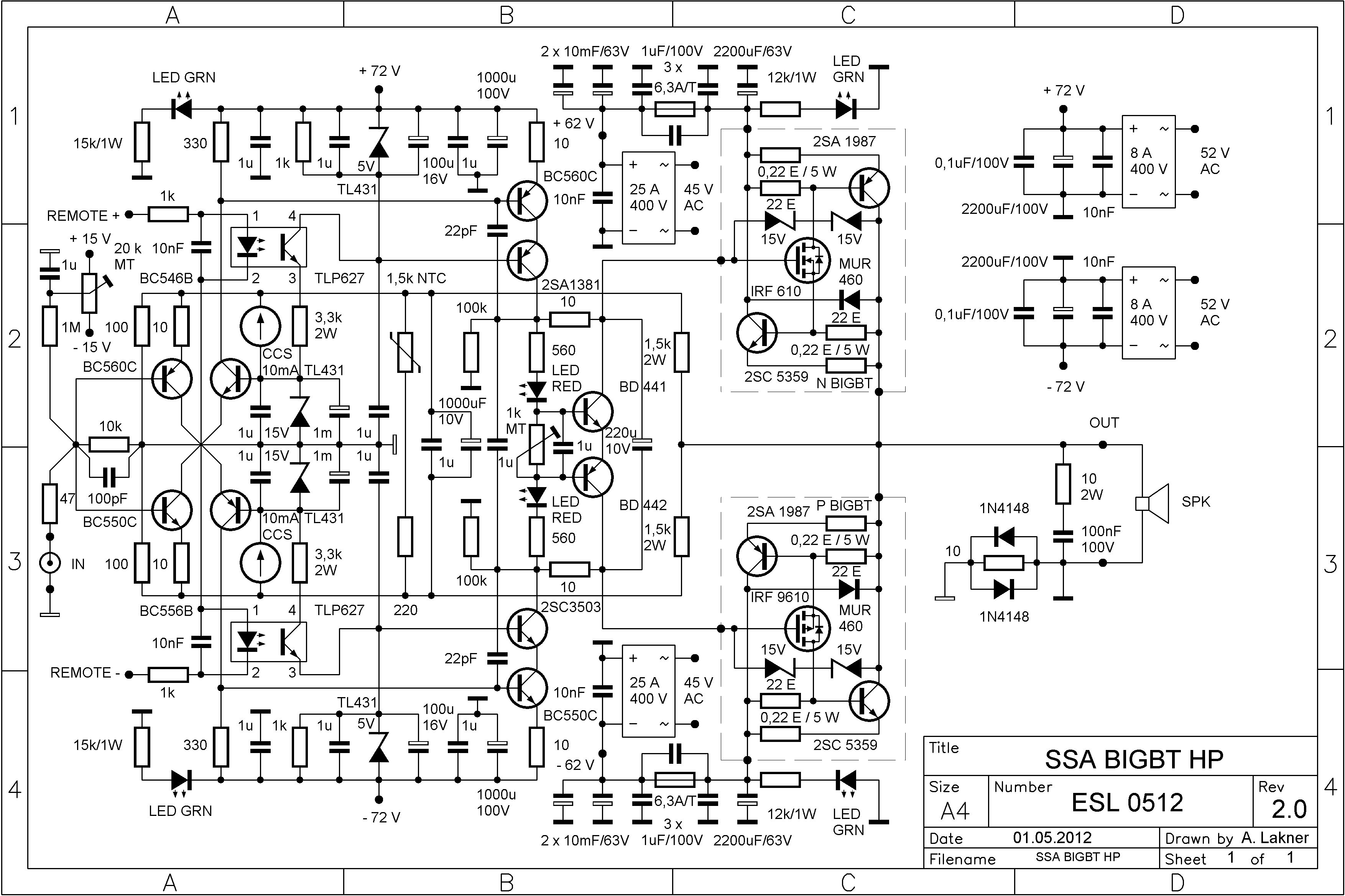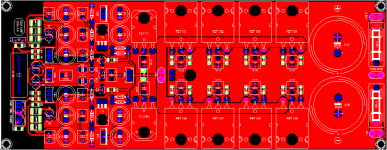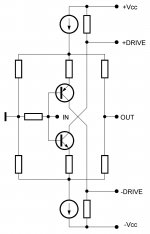What started as a Simple Symmetrical AmplifierSymetrical amplifier for those who likes "keep it simple" designs above all. It works without any frequency compensation.
SSA BIGBT HP final product as a result of development in this thread here.
can today when the final version is published
no longer be described as simple: http://www.diyaudio.com/forums/solid-state/193923-simple-symetrical-amplifier-61.html#post3163129
It is now a rather complicated symmetrical amplifier.
A difficult amplifier to build and to understand.
This does not make it bad. Because it is good,
but let us be honest and not call it simple

Last edited:
Simple in in the matter of working principle. If you design each part (Css, or power stage, as example) as a "blackbox", it is simple. And you can build a basic schematic designed with few components.but let us be honest and not call it simple
But i agree, if you look at this schematic with all the spare components, simple is a bad translation of the acronym.
Take-it for 'Sophisticated Symmetrical Amplifier".
Hi Shaan,
Inspiring words....yes i've gone through the thread and tried to add most of the inputs from other diy'rs. The SSA as shown in my scheme should work.... may be with / without problems
I've just started laying out a PCB and hope i could taste this version of SSA in a couple of weeks time...
Inspiring words....yes i've gone through the thread and tried to add most of the inputs from other diy'rs. The SSA as shown in my scheme should work.... may be with / without problems
I've just started laying out a PCB and hope i could taste this version of SSA in a couple of weeks time...
Attachments
Hi Lazy Cat,
I have been playing with different o/p schemes in spice including BIGBT and I have question about it.
It seems to be a combination of a MF / BJT darlington & a MF / BJT CFP so I was wondering why it does not suffer from the oscillation problems we hear about when CFP's switch ?
Regarding the harmonic spectrum that was mentioned a few days ago I have to say that I see almost no difference between:
MF / BJT darlington,
MF / BJT CFP
BIGBT ( combination of both )
All give a very nice spread of steeply falling off HD from 2nd down through 5th.
I have been playing with different o/p schemes in spice including BIGBT and I have question about it.
It seems to be a combination of a MF / BJT darlington & a MF / BJT CFP so I was wondering why it does not suffer from the oscillation problems we hear about when CFP's switch ?
Regarding the harmonic spectrum that was mentioned a few days ago I have to say that I see almost no difference between:
MF / BJT darlington,
MF / BJT CFP
BIGBT ( combination of both )
All give a very nice spread of steeply falling off HD from 2nd down through 5th.
Last edited:
Magna... that is a neat looking PCB.. Do you have a schematic as well..?? output seems interesting...
sorry I Found your LT-spice file..... V-FET...
V-FET...
Nice circuit, like your CCS for current injection.. are you sure the 1k Ohm resistor from the rail to the inner spread is not too big..??
sorry I Found your LT-spice file.....
Nice circuit, like your CCS for current injection.. are you sure the 1k Ohm resistor from the rail to the inner spread is not too big..??
Last edited:
During this week-end, L.C. had listened to his class D amp, to compare with his SSA.
The following silence indicate or:
1- LC is working nervously on his SSA, trying desperately to compete...
2- He committed suicide.
Hi guys, still alive hehe

It's been a while from my last posting, many things happened since, great activity in local audio forum too, immediate current job obligations, preparing CSA, etc., so ran out of time completely.

Probably you all want to hear my opinion regarding listening test of SSA and NC400. Well it was more or less short one, few hours only, but can say firmly the amps are similar in a character and musical presentation in general. From there on subtle differences are noticable, some in a favour to NC400, some to SSA, have to be fair and honest. NC400 Class D modules are serious competitors to any existing linear amp not just to SSA, so let's wait and see what future will bring us. Certainly only one test in a not very known system to me, couldn't be pronounced as final reference but real clues undoubtedly are present here.

Of course SSA can always do better, not big limitations factors present here, it can be only to change the type of power supply capacitors to make different sound character or some other small changes as you all know.
In general nothing to worry about, keep on with great SSA projects because it really can't be much easier way of getting almost perfect amp as SSA is.

Regards Andrej

Hi MikelmHi Lazy Cat,
I have been playing with different o/p schemes in spice including BIGBT and I have question about it.
It seems to be a combination of a MF / BJT darlington & a MF / BJT CFP so I was wondering why it does not suffer from the oscillation problems we hear about when CFP's switch ?
I'm not sure if I understand correctly what you mean but all share one common feature, that is mosfet driver, which serves to isolate sensitive voltage drive signal from VAS to transfer it almost ideally to base and consequently to collector current of the output device. Looks like a BIGBT as a combination of both, collects more positive features and at the end results in a superior triple-to-one device than just common BJT driver-output devices.
As higher harmonic distortions clearly showing to be lower, indicates that output regulation for circuit inside feedback loop can do better in a broader bandwidth region because of ease of drive an outputs - less VAS distortion.Regarding the harmonic spectrum that was mentioned a few days ago I have to say that I see almost no difference between:
MF / BJT darlington,
MF / BJT CFP
BIGBT ( combination of both )
All give a very nice spread of steeply falling off HD from 2nd down through 5th.
Hi Shaan,
Inspiring words....yes i've gone through the thread and tried to add most of the inputs from other diy'rs. The SSA as shown in my scheme should work.... may be with / without problems
I've just started laying out a PCB and hope i could taste this version of SSA in a couple of weeks time...
Congratulations Magna for the courage and exploring spirit you've presented. This could result to low Zout SSA version handling complex impedance speakers into high powers. Hats off to you, regards Andrej

I was sure of that. As i can imagine the slight differences you noticed.Hi guys, still alive hehe
A little more apparent power, ease and separation with the "D". But the last end of the notes seems to miss a while and the whole character is cold. Sound is lighter
More warm, naturel, and details in reverberation with the SSA. The air between instruments is more "touchable". Sound is more flowing.
Thus last one seems to ADD a little something to the source, the class D to remove something.
Is-it that ? (Please confirm or deny)
What those two amps have in common ? Hight slew rate !
I congratulate you, LC, for your very objective way to be...and listen... I'm full of admiration. It is part of your talent, and one of the reason you design nice amps.
When two amps are so near from each others, with so different technology, and so far from most of all others, guess who are the transparent ones ?
I'm very happy. Remember, i was mocked when talked about D class (and horns ;-)
Very happy, because D class is a near non explored country.
Now, you have explored what i take for the best in analog amps, (May-be error correction left), a large plain is waiting for you talent: Class D and digital amplification.
Last edited:
I had opened a thread about future work in D class, waiting for you all...Ideas... desires...
[COLOR=#0000FF ]http://www.diyaudio.com/forums/class-d/221853-exploring-class-d-improvements-ideas-new-post.html[/COLOR]
[COLOR=#0000FF ]http://www.diyaudio.com/forums/class-d/221853-exploring-class-d-improvements-ideas-new-post.html[/COLOR]
I was sure of that. As i can imagine the slight differences you noticed.
A little more apparent power, ease and separation with the "D". But the last end of the notes seems to miss a while and the whole character is cold. Sound is lighter
More warm, naturel, and details in reverberation with the SSA. The air between instruments is more "touchable". Sound is more flowing.
Thus last one seems to ADD a little something to the source, the class D to remove something.
Is-it that ? (Please confirm)
Not this one, NC400 are a huge difference, a great step forward compared to all other class D amps. It has as dark character as SSA, last end of notes played out to the last detail, nothing lost, not a slightest detail. Air among instruments, perfect separation, huge dynamics, ease of listening, brain processing power zero, only music is played. I was affraid that NC400 would have the same black silence where all details and notes reverberations are lost, not heard any more. But not NC400 reproduce everything to the last possible detail, meaning it has perfect pulse width modulation generator (triangle ramp and comparator), nothing is lost there. Also discrete circuit realization and perfect high level global negative feedback (large OLG) makes this amp almost perfect. Really good to have them in my posession also as a firm reference to compare to.

I had opened a thread about future work in D class, waiting for you all...Ideas... desires...
[COLOR=#0000FF ]http://www.diyaudio.com/forums/class-d/221853-exploring-class-d-improvements-ideas-new-post.html[/COLOR]
Really sorry, never made any class D amp before, so could not help much. I listened them a lot of times but never could listened them for a long time, because you could hear everything, except music wasn't there. NC400 are not of that kind, so to do better as they are is almost impossible, because that would mean to be smarter as Mr. Bruno Putzeys is, that I am clearly not.
Hum...because that would mean to be smarter as Mr. Bruno Putzeys is, that I am clearly not.
You are comfortable with electronic design, enough knowledge, you correlate technical things with a real clever listening sensibility, you are objective and your ego does not blind your judgment...
Smarter ???
Different, as a human being for sure, and the same landscape from different eyes, gives different pictures... You will have different approaches and that gives more chances...
What started as a Simple Symmetrical Amplifier
can today when the final version is published
no longer be described as simple: http://www.diyaudio.com/forums/solid-state/193923-simple-symetrical-amplifier-61.html#post3163129
It is now a rather complicated symmetrical amplifier.
A difficult amplifier to build and to understand.
This does not make it bad. Because it is good,
but let us be honest and not call it simple
Hi lineup
SSA BIGBT HP 2.0 sch has the same basic topology principle as the one from post one, only that is transformed to be much more universal to majority speakers demands available on the market, regarding power/current levels. Nothing really special here, three stage amp as usual, only that it has CFB topology, input/output signal subtraction in a first stage so all parts of the circuit inside feedback loop, except input low-pass filter. Basic principle of this topology attached.
Attachments
But, in Lazy Cat, is the word... Lazy ?
Indicating that I am lazy in my nature, trying to find ways to do things easier and faster, to gain more remaining time, to perform laziness.
Like time to login in your site ?Indicating that I am lazy in my nature, trying to find ways to do things easier and faster, to gain more remaining time
To lineup about "A difficult amplifier to build":
I believe not, because it does-not require complicated tuning or exotic parts and is rock stable.
- Status
- This old topic is closed. If you want to reopen this topic, contact a moderator using the "Report Post" button.
- Home
- Amplifiers
- Solid State
- Simple Symetrical Amplifier


